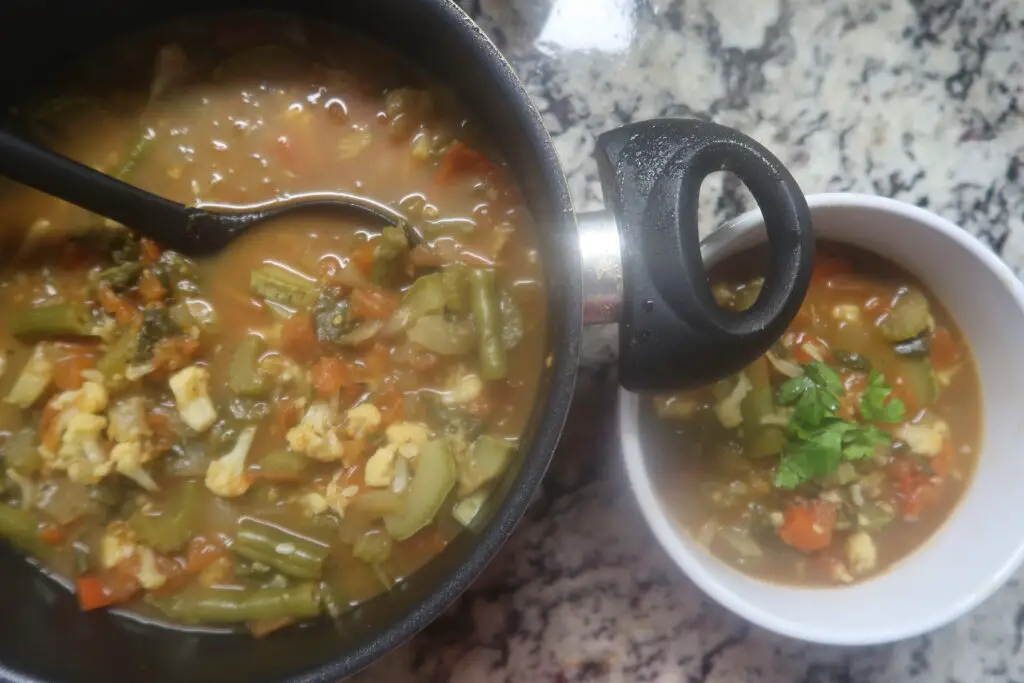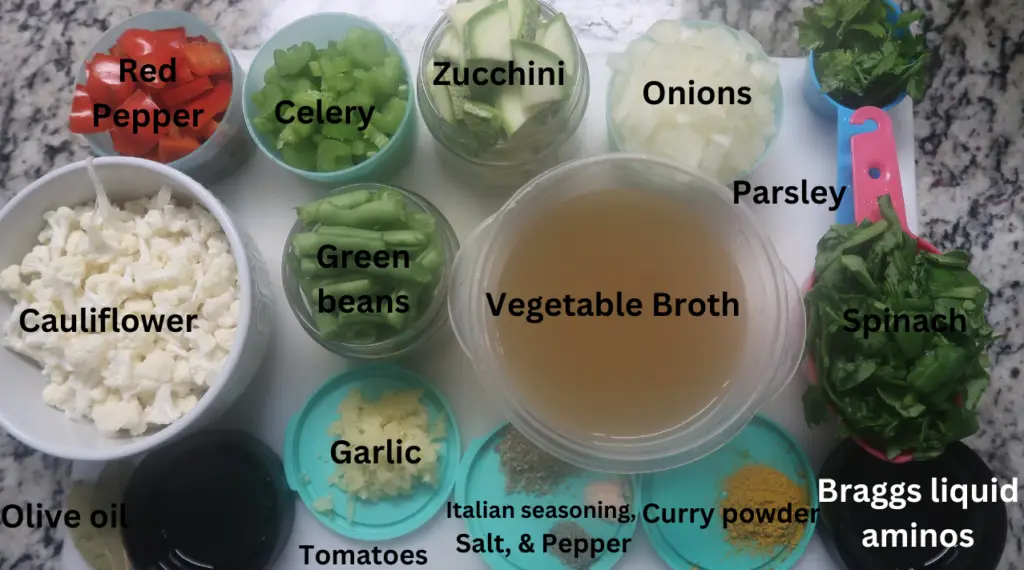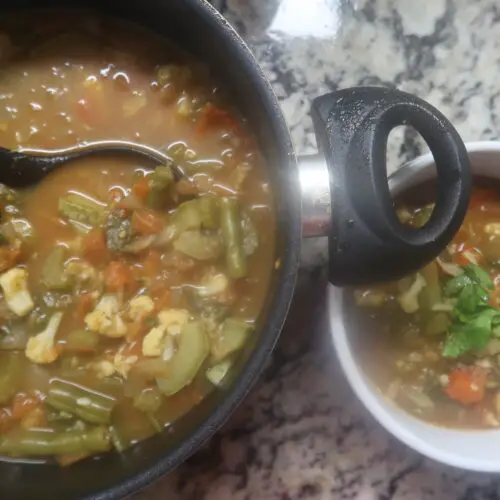Garden Vegetable Soup
By: Toya. L
Enjoy this nourishing and flavorful soup packed with a variety of nutrient-rich vegetables. It’s a comforting and satisfying option for those looking to enjoy a delicious meal while prioritizing their well-being. This soup includes a colorful array of vegetables such as cauliflower, green beans, onions, celery, bell peppers, tomatoes, spinach, and more, creating a vibrant and visually appealing dish. These vegetables provide essential vitamins, minerals, and antioxidants, contributing to a well-balanced diet. Have a bowl of warm and wholesome goodness that not only pleases the taste buds but also supports a balanced and health-conscious lifestyle. It’s a great way to get your daily dose of vegetables and feel nourished and satisfied at the same time.
This post may contain affiliate links. Please read our disclosure policy

This Garden Vegetable Soup is delicious, and perfect for a healthy lunch, or dinner, or on a cold winter night. I personally like to eat soup year-round. This is one of my favorite comfort soups. The curry powder, and the Braggs liquid aminos are my two secret ingredients to giving this soup a delicious favorable taste. I like to make it a day before and let all of the flavors marinate together.
Is vegetable soup healthy?
- Yes, vegetable soup is generally considered a healthy option. It’s low in calories, rich in vitamins, minerals, and dietary fiber, making it a good choice for those looking to maintain a balanced diet.
- Is vegetable soup suitable for weight loss or low carb friendly?
- Vegetable soup can be a part of a weight loss plan as its low in calories and filling due to the fiber content. It is also low carb and keto friendly. However, portion control and overall dietary choices are crucial for weight management.
- Is vegetable soup suitable for weight loss?
- Vegetable soup can be a part of a weight loss plan as it’s low in calories and filling due to the fiber content. However, portion control and overall dietary choices are crucial for weight management.
- Is vegetable soup suitable for weight loss?
- Vegetable soup can be a part of a weight loss plan as it’s low in calories and filling due to the fiber content. However, portion control and overall dietary choices are crucial for weight management.
❤️What’s there to love about this Garden Vegetable Soup❤️
- Nutrient-Rich: Garden vegetable soup is a nutrient powerhouse. It’s loaded with a variety of vegetables, providing essential vitamins, minerals, and antioxidants. This makes it a great choice for maintaining overall health.
- High in Fiber: The combination of vegetables in this soup is a good source of dietary fiber. Fiber promotes digestive health, helps control blood sugar levels, and contributes to a feeling of fullness.
- Comforting: Vegetable soup is a warm and comforting meal, making it an excellent choice for cold or rainy days. It’s often associated with feelings of coziness and well-being.
- Easy to Make: Making vegetable soup is relatively simple, even for novice cooks. You can prepare it on the stove, in a slow cooker, or an instant pot, and it doesn’t require advanced culinary skills.
- Budget-Friendly: Garden Vegetable Soup is an economical choice, as it can be made using affordable and readily available ingredients. It’s an excellent way to prepare a nutritious meal without breaking the bank.
- Leftovers: Garden Vegetable soup often tastes even better the next day, making it a great option for meal prep.
INGREDIENTS:

RECIPE INSTRUCTIONS:
- Prep the Vegetables:
- Wash, peel (if desired), and chop all the vegetables as indicated in the ingredients list.
- Sauté the Aromatics:
- In a large pot, heat the olive oil over medium heat. Add the chopped onion and garlic, and sauté for a few minutes until they become translucent and fragrant.
- Add the Base Vegetables:
- Add the celery, the bell pepper, and the zucchini to the pot. Sauté for 5-7 minutes, or until the vegetables start to soften.
- Incorporate Remaining Vegetables:
- Stir in the green beans. Cook for another 3-4 minutes.
- Broth and Tomatoes:
- Pour in the vegetable broth, add in the diced tomatoes (with their juice) to the pot. Add the cauliflower and stir in the Italian seasoning, salt, pepper. Next add in the curry powder.
- Braggs liquid aminos and Bay leaves: Add in the Braggs liquid aminos, and the bay leaves.
- Simmer:
- Bring the soup to a boil, then reduce the heat to a simmer. Cover the pot and let it simmer for about 25-30 minutes, or until the vegetables are tender.
- Leafy Greens:
- Just before serving, add the leafy greens (e.g., spinach) to the soup. Let them wilt for 5-10 minutes.
- Taste and Adjust Seasoning:
- Taste the soup and adjust the seasoning with more salt and pepper if needed. Remove the bay leaves.
- Serve:
- Ladle the garden vegetable soup into bowls. Garnish with fresh herbs like parsley or basil, if desired.
- Enjoy:
- Serve your delicious homemade garden vegetable soup hot, perhaps with a sprinkle of grated parmesan cheese if you like.

Garden Vegetable Soup
Equipment
Ingredients
- 2 tbsp Olive oil
- 1 medium Onion
- 5 cloves Garlic
- 1 cup Celery
- 1 large Red bellpepper
- 1 cup Zucchini
- 1 cup Green beans
- 4 cup Vegetable broth
- 3 large Tomatoes Can also use 2 cans of tomatoes.
- 2 cup Cauliflower
- 2 tbsp Italian Seasoning
- 1 tsp Salt
- 1/4 tsp Pepper
- 1/2 tbsp Curry powder
- 4 tbsp Braggs liquid aminos
- 2 large Bay leaves
- 1 cup Spinach
Instructions
- Prep the Vegetables: Wash, peel (if desired), and chop all the vegetables as indicated in the ingredients list.
- Sauté the Aromatics:In a large pot, heat the olive oil over medium heat. Add the chopped onion and garlic, and sauté for a few minutes until they become translucent and fragrant.
- Add the Base Vegetables: Add the celery, the bell pepper, and the zucchini to the pot. Sauté for 5-7 minutes, or until the vegetables start to soften.
- Incorporate Remaining Vegetables: Stir in the green beans. Cook for another 3-4 minutes.
- Broth and Tomatoes: Pour in the vegetable broth, add in the diced tomatoes (with their juice) to the pot. Add the cauliflower and stir in the Italian seasoning, salt, pepper. Next add in the curry powder
- Braggs liquid aminos and Bay leaves: Add in the Braggs liquid aminos, and the bay leaves.
- Simmer: Bring the soup to a boil, then reduce the heat to a simmer. Cover the pot and let it simmer for about 25-30 minutes, or until the vegetables are tender.
- Leafy Greens: Just before serving, add the leafy greens (e.g., spinach) to the soup. Let them wilt for 5-10 minutes.
- Taste and Adjust Seasoning: Taste the soup and adjust the seasoning with more salt and pepper if needed. Remove the bay leaves.
- Serve: Ladle the garden vegetable soup into bowls. Garnish with fresh herbs like parsley or basil, if desired.
- Enjoy: Serve your delicious homemade garden vegetable soup hot, perhaps with a sprinkle of grated parmesan cheese if you like.
Video
Nutrition
TIPS FOR GARDEN VEGETABLE SOUP:
- Choose Fresh Ingredients: opt for the freshest vegetables available. Seasonal and locally grown vegetables often have the best flavor. If possible, visit a farmers’ market for high-quality produce.
- Balance Your Vegetables: Use a variety of vegetables to add depth of flavor and nutrition to your soup. Carrots, celery, onions, bell peppers, zucchini, and tomatoes are commonly used, but you can get creative with your choices.
- Prep Your Ingredients: Ensure all your vegetables are chopped into uniform sizes. This allows them to cook evenly, and it makes for a more visually appealing soup.
- Sauté the Aromatics: Sautéing the onions and garlic at the beginning of the cooking process adds a rich, flavorful base to your soup. Be careful not to brown them too much, as this can make the soup bitter.
- Taste as You Go: Taste your soup as it simmers and adjust the seasoning as needed. Different vegetables and broths may require varying amounts of salt and pepper.
- Garnish and Serve: Garnish your vegetable soup with fresh herbs, a drizzle of high-quality olive oil, a sprinkle of grated cheese, or a dollop of sour cream or yogurt, depending on your taste.
- Experiment and Have Fun: Don’t be afraid to get creative with your garden vegetable soup. Experiment with different combinations of vegetables, herbs, and spices to find your favorite flavor profile.
FLAVOR VARIATIONS:
- Herb-Infused: Experiment with fresh herbs and spices to give your soup a unique flavor. Options include basil, cilantro, thyme, rosemary, oregano, or dill. You can even add a pinch of curry powder or cumin for an exotic twist.
- Spicy Kick: For a bit of heat, consider adding red pepper flakes, cayenne pepper, or diced jalapeños. Spicy vegetable soup can be a delightful change.
- Creamy Upgrade: Transform your garden vegetable soup into a creamy version by blending a portion of the cooked vegetables with an immersion blender or in a regular blender. Stir in some cream, coconut milk, or a dairy-free alternative for a rich and velvety texture.
- Lemon Zest: A squeeze of fresh lemon juice or a bit of lemon zest can brighten up the flavors of your soup and add a refreshing, citrusy note.
- Umami Boost: Enhance the depth of flavor by adding ingredients like soy sauce, Worcestershire sauce, or a splash of balsamic vinegar. Umami-rich ingredients can give your soup a savory and complex taste. We added Braggs liquid aminos for an extra depth of flavor.
- Cheese Lover’s Delight: If you enjoy cheese, consider melting some grated Parmesan, cheddar, or Gruyère into your vegetable soup. This adds a delicious richness and depth to the flavor.
- Curry Influence: Create a curried vegetable soup by adding a blend of curry spices like cumin, coriander, turmeric, and ginger. Coconut milk pairs wonderfully with curry flavors.
- Mediterranean Twist: Incorporate Mediterranean flavors by including ingredients like Kalamata olives, capers, and roasted red peppers. Garnish with feta cheese and fresh herbs like parsley.
- Asian Fusion: Create an Asian-inspired vegetable soup by adding ingredients like Bok choy, bamboo shoots, and shiitake mushrooms. Flavor it with ginger, soy sauce, and sesame oil.
- Roasted Vegetables: Roasting some of the vegetables before adding them to your soup can deepen the flavor. Roasted tomatoes, bell peppers, or root vegetables can be a delicious addition.
- Pesto Perfection: Stir in a spoonful of homemade or store-bought pesto just before serving for a burst of herbal, garlicky goodness.
- Tangy Tomato: For a classic tomato-based vegetable soup, increase the number of tomatoes, and include ingredients like roasted garlic and fresh basil.
STORING, FREEZING, AND THAWING INSTRUCTIONS:
- Cooling: Allow your soup to cool to room temperature before storing. Hot soup can raise the temperature inside your refrigerator or freezer, which is not safe.
- Refrigeration: If you plan to consume the soup within a few days, store it in a covered airtight container in the refrigerator. Properly cooled vegetable soup can stay fresh in the fridge for up to 3-4 days.
- Label and Date: Always label the container with the date when you prepared the soup. This helps you keep track of its freshness.
Freezing Garden Vegetable Soup:
- Cool and Portion: Allow the soup to cool completely before freezing. You can portion it into serving-sized containers or use a larger container for the whole batch.
- Airtight Containers: Use airtight containers or heavy-duty freezer bags designed for soups. Leave some room at the top of the container to allow for expansion as the soup freezes.
- Remove Air: If using freezer bags, try to remove as much air as possible before sealing. This helps prevent freezer burn.
- Label: Label each container or bag with the date of freezing. You can also write the type of soup and any special instructions if necessary.
- Flat Freezing (for bags): If using freezer bags, consider laying them flat on a baking sheet to freeze. This allows for easy stacking and saves space.
Thawing Garden Vegetable Soup:
- Refrigerator Thawing: The safest method for thawing your soup is to transfer it from the freezer to the refrigerator. This process is gradual and keeps your soup at a safe temperature. It may take several hours or overnight to thaw completely, depending on the soup’s size.
- Cold Water Thawing: If you need to thaw your soup quickly, you can use the cold water method. Place the sealed container or bag in a larger bowl or basin of cold water. Change the water every 30 minutes. Be sure the soup is in a watertight package to avoid contamination.
- Microwave Thawing: When you’re in a hurry, you can use the microwave to defrost the soup. Use the defrost or low power setting and check and stir the soup regularly to ensure even thawing. Do not use the microwave for long periods to prevent cooking the soup.
- Stovetop Reheating: Once your soup is thawed, you can reheat it on the stovetop over low to medium heat. Stir it occasionally, and be careful not to bring it to a boil too quickly. This method may be necessary if your soup has separated slightly during freezing.
Remember that when thawing and reheating, it’s essential to heat the soup to a safe temperature (165°F or 74°C) to kill any potential bacteria that might have developed during storage or thawing.
FREQUENTLY ASKED QUESTIONS:
- What is garden vegetable soup?
- Garden vegetable soup is a type of soup made primarily from a variety of fresh vegetables, typically simmered in a flavorful broth. It’s a versatile and healthy dish that can include a wide range of vegetables.
- Can I customize the ingredients in garden vegetable soup?
- Absolutely! You can customize the vegetables, herbs, and spices in your soup to suit your preferences. It’s a flexible dish that allows for creativity in the kitchen.
- Can I make garden vegetable soup with canned vegetables?
- While using fresh vegetables is ideal, you can use canned vegetables in a pinch. Just be mindful of the salt content in canned vegetables and adjust the seasoning accordingly.
- Can I add protein to garden vegetable soup?
- Yes, you can add protein sources like tofu, chicken, or ground meat to make the soup more filling and nutritious. Just remember to keep the carb amount in mind.
- What herbs and spices work well in garden vegetable soup?
- Herbs like thyme, rosemary, basil, parsley, and spices like garlic, onion powder, and black pepper are commonly used to flavor garden vegetable soup. These can be adjusted to your taste.